牛津上海版英语八年级下册教案:U1Trees
牛津上海版八年级下册 Unit 1 Trees 教学设计

牛津上海版八年级下册 Unit 1 Trees 教学设计一. 教材分析牛津上海版八年级下册Unit 1 Trees的主题是关于树木。
本单元主要通过学习树木的相关知识,让学生了解树木的重要性以及人类与树木之间的关系,提高学生对环境保护的意识。
教材中包括阅读材料、词汇学习、语法练习、听力、口语等多种类型的教学内容,旨在全面提高学生的英语综合运用能力。
二. 学情分析八年级的学生已经具备了一定的英语基础,能够进行简单的英语交流。
但部分学生在词汇量和语法知识方面还有待提高,因此需要在教学过程中针对性地进行辅导。
此外,学生对环境保护的认识各有不同,需要通过教学活动引导他们关注环境保护的重要性。
三. 教学目标1.知识目标:学生能够掌握与树木相关的词汇和表达方式,了解树木的重要性及人类与树木之间的关系。
2.能力目标:学生能够运用所学知识进行听力、口语、阅读和写作练习,提高英语综合运用能力。
3.情感目标:学生能够提高环保意识,认识到保护树木和环境的重要性。
四. 教学重难点1.重点:学生能够掌握与树木相关的词汇和表达方式,提高英语听说读写能力。
2.难点:学生能够运用所学知识进行实际场景的英语表达,提高英语口语和写作能力。
五. 教学方法1.任务型教学法:通过设置各种任务,让学生在实际语境中运用所学知识,提高英语综合运用能力。
2.情境教学法:创设相关情境,让学生在轻松愉快的氛围中学习英语。
3.合作学习法:鼓励学生分组讨论、合作完成任务,提高团队协作能力。
六. 教学准备1.教学材料:教材、多媒体课件、相关视频资料、练习题等。
2.教学设备:投影仪、计算机、音响设备等。
七. 教学过程1.导入(5分钟)利用图片或视频展示不同种类的树木,引导学生谈论树木的特点和作用,激发学生对树木的兴趣。
2.呈现(10分钟)讲解教材中关于树木的词汇和表达方式,如“pine tree”、“oak tree”等,并通过例句展示这些词汇的用法。
3.操练(15分钟)设计听力练习,让学生听录音并选出正确的树木名称。
八年级英语下册 Unit 1 Trees教案 (新版)牛津上海版

Unit 1 Trees1教学目标Language skills 语言技能The students can collect the Frame Elements ( verb-phrases)The students can put the Frame Elements into sentences.The students will be able to write a passage with proper use of Frame Elements and useful patterns based on the Frameworks to describe their ideas about pollu tion.Language knowledge. 语言知识The students can use the key phrases and expression upon environment .The students can better understand the functions of present tenseEmotion 情感态度By involv ing the students’ on pollution problem, the students will be able to share their ideas and suggestion on protecting the environment.D. Learning strategies 学习策略1、The students will learn to be cooperative in group to complete the task.2、 The students will be able to use Framework to organize their vocabulary kno wledge and carry out their writing .2学情分析I don’t know any basic things relating to English writing about my would-be st udents in NanWu middle school . But I have to predict and try to conduct my tea ching adjustably on the realistic teaching that day . supposedly , the students have a unit-long inputs and intakes about the topic –protecting the environme nt , including the words and expressions, to describe pollutions around us or j ust a little .On one hand ,they are more likely to asked to finish a writing ab out their ideas about the pollutions in the writing part. On the other hand , in order to meet the requirement of a writing lesson , they will have to learn h ow to accomplish a writing to express their opinions about pollutions by my les son . Therefore ,what I will do is to put them to build up Framework step by st ep for the writing led by my teaching belief .3重点难点V 、Teaching focuses 教学重点、难点To collect the Frame Elements of students on pollutions.To help students put their Frame Elements (verbs) into sentences.To help students to output their passage with proper use of Frame Elements and useful patterns based on the Frameworks to describe their ideas about pollutio n.4教学过程教学活动活动1【活动】ⅥI、Teaching procedures 教学过程ⅥI、Teaching procedures 教学过程PhaseSpecific aimsTeacher’s activityStudents’ activitySkills involvedStep1:Pre-writing⑴ Brainstorm& Lead-in (Q and A)To arouse students’ interests and lead them in the teaching .Brainstorming the students through questions and answers.Be guided by questions and get involved in class⑵ Classify the pollutions1 To get students to classify the pollutionsTo brainstorm the students about their understand about pollutions and get them to classify the four kinds of pollutions1. To write down the kinds of pollutions on the worksheetTo identify the pollutions(3) Collect the Frame Elements1.To get students to Collect the Frame Elements (verbs )1. To recall students’ verbs to problems and solutions2. To get students to write down their verbs1. To shout out the verbs according the pollution problems2.To mark down the verbs beforehand.y down Elements for later sentencesTo collect the Frames elements and get ready for sentences as to link the sub-f rames.Step2 :While-writing)(1)Construct the sentencesTo help students to construct correct sentence.1. To have the students observe sentences about problems and solutions made with verbs . .2. To guide students to make their own sentences about problems and solutions.1. To write down their sentencesTo put the Frame Elements into correct sentences.phaseSpecific aimsTeacher’s activityStudents’ activitySkills involved(2) Clear minds by the FrameworkBefore starting to writing1.To help students to understand what they have learned in the writing lesson b y going through the Framework on water pollution .2. To guide students’ to carry out their passage by the Framework .1. To make students follow the Framework while writing .2. To offer necessary help to the students .1. To have a taste of a passagewith opinion about gas pollution as well as be conducted under a Frame pattern2. To write the passage guided by the Framework –Water pollution .To guide their writing with Framework.(3)Output the passage based on the Framework1、To get students to output their paragraphs at one specific pollutionTo ask the students to finish a paragraph about water / air pollution on their Frameworks.To finish the writing according based on the Framework .To write a paragraph based on the Frameworks.Step3:Post-writing Peer assessmentsTo evaluate the works and to stimulate their writing .1. To give out the evaluating criteria.2. To evaluate one or two samples publicly.3. To get students to finish the peer assessments.1. To evaluate each other.2. To reflect their writing and adjust for improvement.To be cooperativeand developmental.Step 4 Sum-up and assign homework1.To help students retrospect their learning objectives2. To get students to write passage protecting environment .。
2020 牛津上海春季八年级英语下册Unit1 Trees 学案设计

教师姓名学生姓名年级初二上课时间学科英语课题名称Unit1 Trees 同步教案Ⅰ. Important words:1.___________ v.破坏;毁坏___________ n.毁灭;毁坏2.___________ n.战士___________ v./n.战斗,打架3.___________ n.产品4.___________ n.喧闹声,噪音Unit1 Trees同步教案___________ n.制片人,制作者___________ v.生产___________ adj.吵闹的;嘈杂的___________ adv.吵闹地5.___________ n.事实___________ n.因素6.___________ v.呼吸___________ n.呼吸7.___________ adj.感到有兴趣的___________ adj.令人产生兴趣的___________ n.兴趣,爱好8.___________ n.科学家___________ n.科学___________ adj.科学的9.___________ adj.纯净的___________ adj.纯净地10.___________ v.警告___________ n.警告;告诫11.___________ v./adj. 居住/现场的___________ adj.活着的___________ adj.活的,有活力的___________ adj.活泼的12.___________ adj.化学的___________ n.化学物质(复)___________ n.化学学科___________ n.化学家13.___________ v./n.燃烧/烧伤___________ adj.(只用于名词前)燃烧着的,迫在眉睫的14.___________ adv.几乎___________ adv./adj.努力地/艰难的;坚硬的15.___________ n.害处___________ adj.有害的___________ adj.无害的16.___________ v.享受___________ n.享受;快乐___________ adj.令人愉快的17.___________ v./n.交流;交换___________ v./n. 改变;替换18.___________ v.放回原处;更换;替换___________ n.更换;接替的人或物19.___________ v.交流沟通___________ n.交流沟通20.___________ v.感谢___________ adj.感谢的,感激的21.___________ adj.主要的___________ adv.主要地22.___________ adj.自然的___________ n.自然【小试牛刀】Ⅰ. Fill in the word in its proper form(用以下单词的合适形式填空)(错误率:掌握情第2页况:)1. live alive living livelyMy parents just ________ across the street from the Browns’.She is one of the greatest ________ actresses in our country.Trees provide fresh air to keep people ________ and healthy.This building is located next to a ________ and busy port(港口).2.chemical chemicals chemistry chemistThey use some ________ ways to make the soil look better.In Britain, people can buy some beauty products in a ________ .We'll learn the science of ________ in Grade Nine.They add some poisonous ________ to the ingredients in order to make food more delicious.3.science scientist scientificEncyclopedias, history books and ________ books are non-fiction books.We should learn ________ farming.Quite a lot of Chinese ________ work on the South Pole.These business made their decisions based on ________ research.4. noise noisy noisilyI didn't sleep well because of the ________ of the traffic.It’s so ________ outside that we can't hear the teacher's words clearly.David always blows his nose ________ .5. fact factorWe have duty to provide ________ for our readers.Price is the deciding ________ for us to buy a house.6.know unknown well-knownAs we all ________ , the Great Wall is one of the most famous wonders in the world.An ________ woman won the tennis competition. Where does she come from?Wang Yaping, the Chinese woman astronaut, is ________ in the world.7.product producer produceThis book was the ________ of many years’ hard work.How did this factory ________ around 100 cars per hour?This country is one of the leading oil ________ .8.thank thankfulMy daughter ________ her uncle for the nice present yesterday.I’m ________ to have made such progress.9.main mainlyThe ________ reason for living in Shanghai is the friendly people around.My mum doesn’t like going out much, ________ because she has to look after the whole family.10.nature naturalAll these materials can be found in ________ .He is born with the ________ ability with figures.11.pure purelyLook, the fantastic ring is made of ________ told.Your team won the first prize ________ by chance.Ⅱ. Important phrases:pollution fighters抗污染的战士第4页fighters against pollutiona class project on pollution在污染方面的课题be interested in在…方面有兴趣living things on the earth地球上的生物make streets more beautiful and less noisy使街道更漂亮少些吵闹on the end of …在…的末端enjoy breathing pure cool air喜欢呼吸纯净凉爽的空气What else…?还有什么…?thank sb. for …为…感谢某人natural air conditioners天然空调take harmful gas from the air从空气中带走有害气体release oxygen into the air把氧气释放进空气one and a half hectares of trees 1.5公顷的树keep the whole class alive and healthy使整个班级有活力且健康as well as也,还almost all day几乎一整天for example例如attack a tree袭击一棵树warn sb. (not) to do sth.警告某人(不)要做某事protect sb. by doing sth.通过做某事来保护某人protect sb. from /against doing sth.make sth. taste nasty使某物尝起来很难吃communicate with one another相互交流be in danger处于危险cut down砍倒,砍伐Ⅲ. Important sentences:1. What else…?还有什么……?【记忆链接】What else do you want to buy? 你还想买些什么?同类词:something else/somebody else/anyone else/everyone else【注意】所有格与else连用时,-’s要添加在else上。
沪教版牛津英语8Aunit 1 Trees 完整教案(有教学反思)

Unit One TreesPeriod 1 (page 1-2 A-B)知识目标:To learn some important words and phrases.能力目标:1. practise speaking skills2. apply what the students learned in class to practise3. arouse students’ interest of English.情感目标:1. cultivate team spiritI. Teaching aims:1.Overview the whole chapter.2.Introduce the background of the topic: pollutionII. Teaching procedure:Warming upGet students to talk about their winter holiday or Spring festivalPre-task preparation1.Ask the students to guess what the unit’s topic will be by looking at the cartoon ..2.Then ask them to list some things we get from trees that we use ,eat ,drink ,or wear.Somepossible answers are:Use—pencils ,chopsticks, tables ,chairs, paperEat – fruit ,nuts,Drink—tea ( leaves ) ,coffee ( beans )Wear – T—shirts ( cotton ),shoes ( rubber ).3.Ask the students if they think we should have more or fewer trees in Shanghai .Encourage thestudents to tell you why.4.Ask the students to tell you why they think hundreds of trees have been planted alongShanghai’s streets ,such as Century Avenue .5. Poll the class to find out if the students have ever planted a tree. If they have ,ask them whereand for what reasons..While-task procedureReadingA: . Ask the students to do the Quiz. Encourage guesses if the students do not know the answers B: As always ,the students should not read the whole interview. They should only read part of it as required ,guess the answers, and then confirm the correctness of their guesses during their later readings of the interview. The answers should be checked with the students after they complete Exercise D2Homework1. Copy the new words.2. Pre-study the article on page 3Notes:因为是第一节课,学生的兴致比较高涨,听讲效率高,课堂气氛活跃。
牛津译上海英语八年级第二学期:Unit 1 Trees 教案设计

Unit 1 TreesTeaching aimsAt the end of this period, students are expected to:◆Understand the meanings of the following words—average, item, product, fighter, fact, scientist, interested, notebook, suppose, breathe, pure, gas, release, oxygen.◆Get to know the function of trees.◆Arouse the interest in the natural world.Teaching aidsTextbook and multi-media facilities.Teaching proceduresLead-in:●Look at the pictures of different kinds of tress and guess the topic today.●What do you know about:1.How long do they live? Match the living things on the left with the average ages on the right.2.Which kind of pollution do trees help fight?3.Which of the following items come from trees?4.The best-known trees in Shanghai are magnolia trees. Their large, sweet-smelling flowers are known as the city flowers of Shanghai. Which picture shows a magnolia tree?●Before you read:1.Look at the title, the introduction and the pictures.2.Then decide whether the following statements are T or F.➢The pollution fighters are probably scientists.➢Trees are natural air conditioners.➢Trees can pass information to one another.●Read:1.Read the title and the introduction and answer the following questions:➢Who is doctor Ray?➢Why does Judy need to interview Dr Ray.2.Read the first part of the dialog (Line 1~12), learn some key words and phrases: be interested in; notebook, suppose, breathe, pure) and think about the following questions: ➢Why is Dr Ray so interested in trees?➢Judy knows only a little on trees. Can you give an example?➢How many examples does Dr Ray give?➢What are they?3.Read from Line 13~15 of the second part of the dialog and find out how people can breathe pure cool air. Learn the words: gas, release, oxygen. And use them to tell one major function of trees.●Homework:1.Read the dialog after tape.2.Copy new words and recite them.。
Unit1Trees教案2023-2024学年牛津上海版英语八年级下册

4.学习策略:在本单元的学习过程中,学生将学会如何使用字典、参考书籍等资源进行自主学习,培养他们的信息获取和处理能力。同时,学生还将学会如何对所学内容进行总结和归纳,提高他们的学习效率。
-重点词:leaf(树叶)、trunk(树干)、branch(树枝)、fruit(果实)、seed(种子)
-重点句:These trees have leaves that change color and fall off in autumn.(这些树的树叶在秋天会变色并脱落。)
②树木与人类生活的关系
2.思维品质:学生能够分析树木的种类、特点和与人类生活的关系,培养他们的分析、判断和推理能力。通过解决实际问题,如设计一个树木保护计划,学生将能够锻炼他们的创新思维和解决问题的能力。
3.文化意识:学生了解到树木在世界各地文化中的重要地位,培养他们的跨文化交际能力。同时,通过学习环境保护的重要性,学生将增强自己的文化自信,积极传播环保理念。
(三)改进措施
1.课堂管理:加强课堂管理,通过设置明确的学习目标和规则,引导学生积极参与课堂活动,提高学生的学习积极性。
2.教学方法:丰富教学方法,如引入小组讨论、角色扮演、实验等活动,提高学生的参与感和学习效果。
3.教学评价:完善评价体系,注重学生的综合素质和能力培养,采用多元化的评价方式,如课堂表现、作业完成情况、项目实践等,全面评价学生的学习成果。
4.学习策略:学生学会如何使用字典、参考书籍等资源进行自主学习,培养他们的信息获取和处理能力。同时,学生还将学会如何对所学内容进行总结和归纳,提高他们的学习效率。
牛津上海版八年级下册U1教案
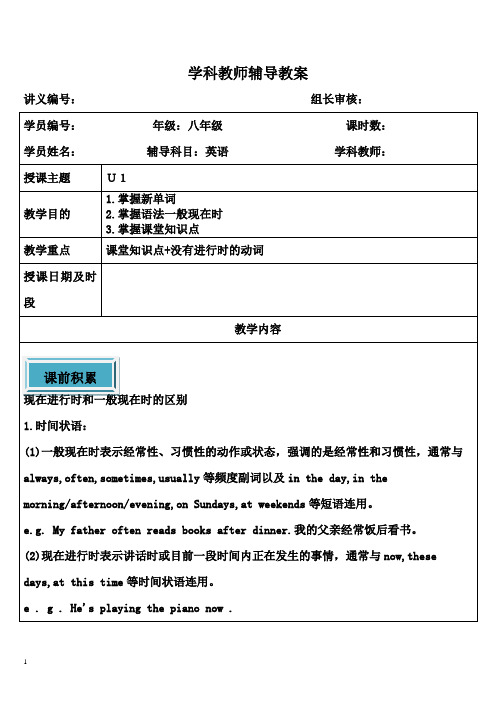
e.g.Mr.Li’sclassislivelyandinteresting.=MrLi’sclassislivelyaswellasinteresting.
24.breathev. 呼吸--breathing breathein 吸入(气体) breatheout 呼出(气体) breathn. 呼吸 takeadeepbreath 深呼吸 beoutofbreath 上气不接下气;喘不过气来 holdone’sbreath 屏住某人的呼吸
20.attheendof… 在……底;在……的尽头 ◆attheendofthemonth 在月底 attheendofthestory 在故事的结尾 attheendoftheroad 在马路的尽头
efrom=befrom 来自 come-came-come
22.supposev.:think(sth.tobetrue) 认为;推断;假设
e.g.Einsteinwasoneofthemostfamousscientistsintheworld. 爱因斯坦是最著名的科学家之一。
7.interestn./v. 兴趣;爱好;利益/ 使感兴趣 –interesteda. 感兴趣的 –interestinga. 有趣的 ◆manyinterests 许多兴趣=manyhobbies showgreatinterestinsth. 对某事表现出极大兴趣 ◆beinterestedinsth./doing 对……感兴趣;=bekeenonsth./doing
33.releaseoxygenbackintotheair 把氧气释放(回)到空气中
上海牛津沪教版八年级(下)同步讲义unit1
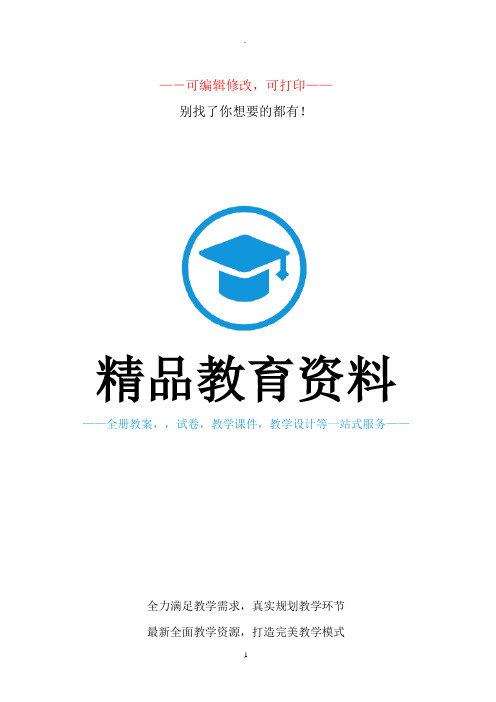
—-可编辑修改,可打印——别找了你想要的都有!精品教育资料——全册教案,,试卷,教学课件,教学设计等一站式服务——全力满足教学需求,真实规划教学环节最新全面教学资源,打造完美教学模式第一讲Unit1 Tree上海牛津沪教版八年级(下)同步讲义Unit1 Tree适用学科初中英语适用年级初中二年级适用区域上海课时时长(分钟)120分钟(一对一)知识点知识点1:本单元词汇知识点2:词组知识点3:句型知识点4:动名词的用法知识点5:不定式的用法知识点6:形容词的比较级与最高级教学目标知识:学生能够基本掌握8年级上册Unit1中的词汇、词组、句型及语法。
方法:牢记各个知识点的用法,归纳总结异同点,通过习题加强巩固。
能力:熟练掌握各种词汇的用法;具备准确判断词性及转换的能力;熟练掌握形容词的比较级与最高级;熟练运用动名词的能力。
教学重点词性转换;形容词副词级别;动名词用法;教学难点不定式的用法教学过程一、课堂导入教师讲述一个与本节课题目有关的英文小故事,引出今日所要讲解的知识点,然后让学生简单梳理一下所涉及的问题,带着问题学习本节课的内容。
二、复习预习教师引导学生复习上节课学的重点内容,检测单词的用法,(以提问、回顾的形式进行),针对上节课的作业进行讲评、订正、答疑,并通过英文小故事导入本节课所要学习的新知识。
三、知识讲解1. 知识点一:重点单词1)average [ˈævərɪdʒ]【词性】adj.【词义】平均的【经典例句】Match the living things on the left with the average ages on the right.把左边的生命和右边的平均年龄连线。
2)item [ˈaɪtəm]【词性】n.【词义】一件物品【易混淆点】item 一件物品;项目event 活动项目【经典例句】Which of the following items come from trees?以下哪件物品时来自树?3)product [ˈprɒdʌkt]【词性】n.【词义】产品【易混淆点】product 产品produce 生产【经典例句】This is kind of new product.这是一款新的产品。
牛津上海版英语八年级下册《Unit 1 Trees》教学设计1
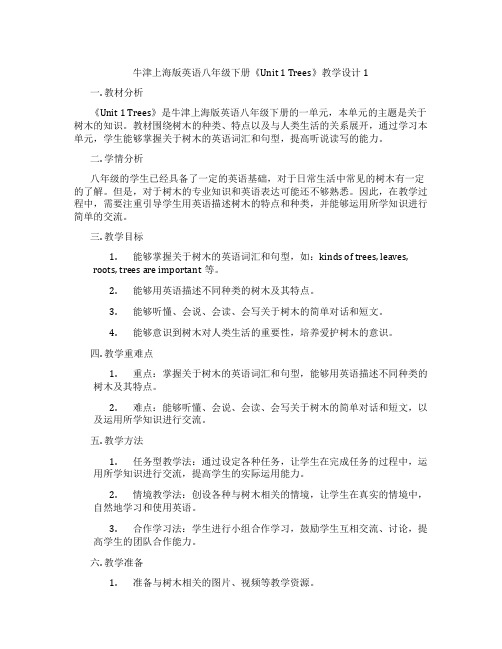
牛津上海版英语八年级下册《Unit 1 Trees》教学设计1一. 教材分析《Unit 1 Trees》是牛津上海版英语八年级下册的一单元,本单元的主题是关于树木的知识。
教材围绕树木的种类、特点以及与人类生活的关系展开,通过学习本单元,学生能够掌握关于树木的英语词汇和句型,提高听说读写的能力。
二. 学情分析八年级的学生已经具备了一定的英语基础,对于日常生活中常见的树木有一定的了解。
但是,对于树木的专业知识和英语表达可能还不够熟悉。
因此,在教学过程中,需要注重引导学生用英语描述树木的特点和种类,并能够运用所学知识进行简单的交流。
三. 教学目标1.能够掌握关于树木的英语词汇和句型,如:kinds of trees, leaves,roots, trees are important等。
2.能够用英语描述不同种类的树木及其特点。
3.能够听懂、会说、会读、会写关于树木的简单对话和短文。
4.能够意识到树木对人类生活的重要性,培养爱护树木的意识。
四. 教学重难点1.重点:掌握关于树木的英语词汇和句型,能够用英语描述不同种类的树木及其特点。
2.难点:能够听懂、会说、会读、会写关于树木的简单对话和短文,以及运用所学知识进行交流。
五. 教学方法1.任务型教学法:通过设定各种任务,让学生在完成任务的过程中,运用所学知识进行交流,提高学生的实际运用能力。
2.情境教学法:创设各种与树木相关的情境,让学生在真实的情境中,自然地学习和使用英语。
3.合作学习法:学生进行小组合作学习,鼓励学生互相交流、讨论,提高学生的团队合作能力。
六. 教学准备1.准备与树木相关的图片、视频等教学资源。
2.准备树木的英语词汇和句型卡片。
3.准备录音机、磁带等录音设备。
4.准备与树木相关的阅读材料。
七. 教学过程1.导入(5分钟)利用图片、视频等教学资源,引导学生谈论日常生活中见的到的树木,激发学生的学习兴趣。
2.呈现(10分钟)利用卡片,呈现本节课的重点词汇和句型,如:kinds of trees, leaves, roots, trees are important等。
牛津上海版英语八下Uint 1《Tree》课件
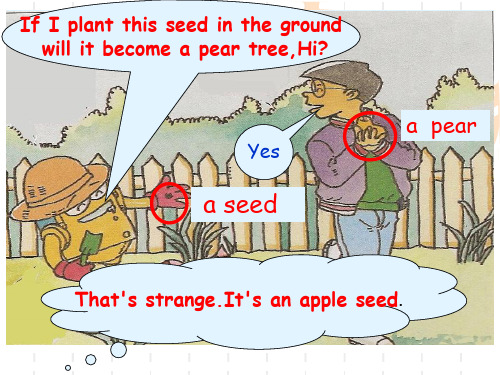
5.For example, whe insects ..., it can warn its neighours.
warn v 警告
I tried to warn him to keep away from that dog, but he would not listen.
warn sb to do sth
2.Why are you so interested in trees?
interested (adj) interesting(adj) interest (n)
感兴趣的 有趣的 兴趣
பைடு நூலகம்
Mary is _in_t_e_r_e_st_e_d_ in _in_t_e_re_s_t_in_g_ coins. She also takes an _in_t_e_re_s_t__ in stamps.
air pollution noise pollution water pollution Which type of pollution do trees help fight?
all of the above
3. Which of the following come from trees?
apples
4.Trees are natural air conditioners.
natural adj 自然的,天生的 nature n. 大自然,天然
Some desert countries have few natural resources. Nature is at its best in spring.
If I plant this seed in the ground will it become a pear tree,Hi?
牛津版上海版八年级下册Unit1TreesReading课件培训资料
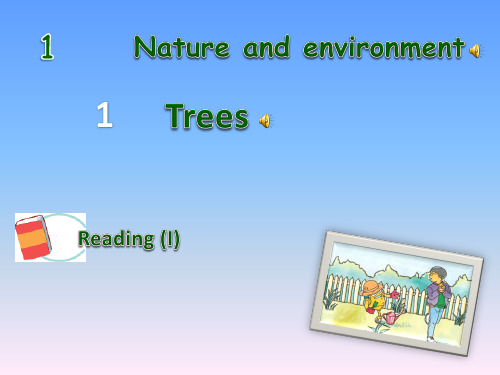
Before you read the interview, try this online quiz.
1 Match the pictures with the words.
a mice b trees c tortoises d whales e humans
i 70 years ii 150 years iii 40 years iv 4,000 years v 3 years
3 What does pollution mean?
4 Which kind of pollution do trees help fight? a) air pollution b) water pollution c) noise pollution d) all of the above
If I plant this seed in the ground, will it become a pear tree, Hi?
Yes, Lo.
That’s strange. It’s an apple seed.
1 Where are Hi and Lo? They are in the garden.
c) Cotton plants are planted fresh every year in tropical and subtropical areas. Cotton is used to make fabrics.
d) oil, e.g., coconut oil, palm oil e) Tea is made from leaves. f) Rubber is made from the sap of the
上海牛津版八年级下册Unit1 Trees 同步讲义 解析版
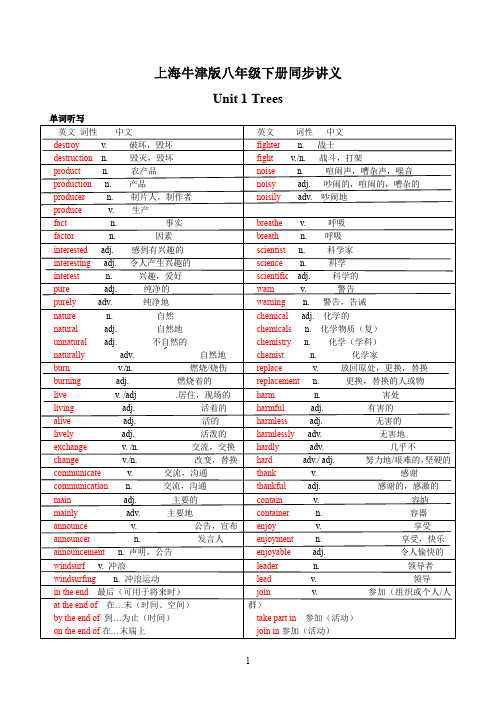
上海牛津版八年级下册同步讲义Unit 1 Trees一、词汇Words1. interest n. 兴趣v. 使好奇--- interested adj. 感兴趣的--- interesting adj. 有意思的,引人入胜的某人对(做)某事感兴趣(1) Now he’s grown up he no longer takes any __ interest ____ in his stamp collection.(2) Are you ____ interest _____ in history?2. living adj. 活着的(做定语)n. (U)生活方式alive adj.活着的(做表语)live adj. 有生命的,现场直播v. 生存,活着有生气的,活泼的e.g. living things 活的生物,make a living 谋生,a live broadcast 现场直播,live in England 住在英国lively imagination 生动的想象力,have a lively time 有一段够刺激的经历3. harm n.& v. 伤害,损害--- harmful adj. 有害的---harmless adj. 无害的harmfully adv.有害地--- harmlessly adv.无害地e.g. (1) Pollution causes ____ harm ____ to lakes and beaches.(2) Gossip can __ harm _____ other people.(3) Smoking is____ harm _____ to your health.n. 化学物品--- chemist n. 化学家--- Chemistry n. 化学(1) __ Chemistry __ change 化学变化(2) _____ Chemistry ___ lab 化学实验室(3) The farmers used a ____ chemical ____ to kill the insects in their fields.5. danger n.----safety (opp.)dangerous adj.----safe (opp.)(1) In war a soldier’s life is full of ____ danger ____.(danger/ dangerous/ dangerously)(2) The river is dangerous ____ for bathers. (danger/ dangerous/ dangerously)(3) Are these toys ____safe ___ for small children? (safety/ safe/ safely)(4) ___ Safety _____ First. (safety/ safe/ safely)6. make(1) make=create 制造,生产e.g. They’ve made a film about her life. 他们拍了一部有关她的生活的电影。
牛津上海版本英语初中八年级的下册的学习教案:U1Trees.doc

牛津上海版英语八年级下册教案: U1TreesU1 Pollution FightersPeriod ITeaching objectives:1)Reviewing and learning some more information about trees.2)Having students catch the general ideas of the whole passage and understand some new words and expressions.e.g. living things, release, oxygen, etc.Difficulties:To read through the whole passage.Teaching aids:Blackboard, computer, over-head projectTeaching proceduresWarming-up:1)Write from the memory.2)Read the comics on page 15 and let students know that we’ll talk about the biggest and oldest living things on earth ----trees. Pre-task preparations:1)Let students talk freely to see how much they know abouttrees and make a guessto see whose number is close to the answer.2)Answer the questions in“What do you know about⋯ ?”While-task procedures:1)Get students to look at the title, the subtitle, and the picturesto tell who are pollution fighters.2) Let students read through the whole passage. Look at thestatements on the screen and let them to find out the facts in the passage to complete the sentences.Post-task activity:1)According to what they’ve known, let them fill in the blanksto finish the sentences. Help students to summarize thegeneral ideas of the passage.Assignments:Oral work: read the interview on page 17.Written work: preview the passage with the help of dictionary. Notes:Period IITeaching objectives:1)Learning the first part of the interview2)Having students review or learn the words and expressionse.g. be interested in, sip, etc.Language focus:1)Helping students pronounce new words correctly and try to memorize2)Doing some exercise to let students understand the language points.Difficulties:Use ‘noisy-noisily-noise, living-alive’correctly to some of them. Teaching aids:Blackboard, computer, over-head projectTeaching proceduresWarming-up:Complete the statements to see how much they remember the information about trees.Pre-task preparations:Ask students the meanings of the new words. They can choose one of the answers. Then learn to read.While-task procedures:1)Review and introduce the words and expressions.2)Do some exercise to help students understand how to use the language points correctly.Post-task activity:Do some exercise by themselves.Assignments:Oral work: read the textWritten work: review the new words and expressions.Notes:默写时间太长以至于后面知识点来不及讲,减少学生做笔记时间,通过练习让学生理解知识点并且运用。
牛津版上海版八年级下册Unit1TreesReading课件
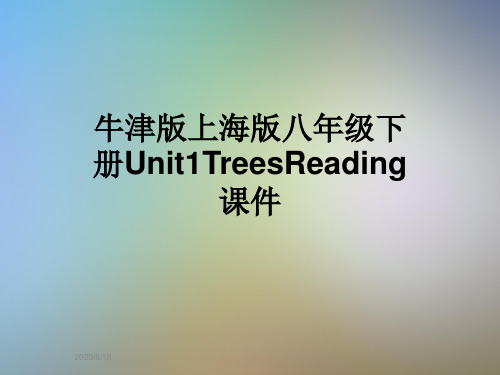
课件
2020/8/18
If I plant this seed in the ground, will it become a pear tree, Hi?
Yes, Lo.
That’s strange. It’s an apple seed.
Magnolia trees (c) are small to medium-sized trees noted for their large, showy blossoms in early spring, and large leaves.
A Before you read the interview, look at the title, the introduction and the pictures.
JUDY Forty-six. DR RAY Well, one and a half hectares of trees could produce
enough oxygen to keep your whole class alive and healthy for a whole year. JUDY That’s wonderful! DR RAY Trees cool the air as well as clean it. They are natural air conditioners. Three trees can do the job of 15 air conditioners running almost all day.
There are many different kinds of palm trees (b). The coconut palm produces coconuts whose outside shell (the husk) can be made into ropes or burned for firewood. The milk can be drunk and the flesh of the coconut can be eaten. Oil pressed from the flesh is used both for cooking and in skin creams. The leaves are used to make brooms.
牛津上海英语八年级第二学期:Unit 1 Trees 学案设计(无答案)

Unit 1 Trees【学习目标】1.学生能够基本掌握词汇、词组、句型及语法。
2.牢记各个知识点的用法,归纳总结异同点,通过习题加强巩固。
【学习重难点】1.能根据要点提示复述课文大意。
2.能背诵课文中的重点句型或句子。
【学习过程】1.pollution fighter 环保卫士= fighter against pollution.污染(v)__________.e.g. ________________________. 我们承诺不污染河流。
噪音污染___________.水污染____________.polluted (adj.) 不干净的。
e.g. ______________________. 别吃不干净的食物。
Fight. (v. /n.)He put up a fight to the end. 他坚持斗争到最后。
Don’t fight with your classmates! 别和班级同学打架。
斗士,卫士________________.环保卫士__________________.2.Fighting 加油!=come on(口语)She is interviewing Doctor Ray, a scientist, about tree.3.Interview (v. /n.) 采访,面试。
我想采访一下我们的校长(headmaster)__________________________________.我有一个面试要参加(to attend)_______________________________________.4.Science n. 科学e.g. It is important to study science and technology.(科学和技术)科学家(n )_______________.e.g. Qian Xueshen was ________________________.一名伟大的中国科学家。
牛津上海版初中英语八年级-Unit1 Trees-第2课时

2、语法知识和词组搭配
(2)词组搭配 keep…alive 表示保持生命力,活着。 Oxygen can keep you alive. 氧气能使你存活。 communicate with 做不及物动词时,意思是“通讯, 沟通,交流”。其常用搭配为:communicate with somebody,意思是“和某人沟通/交流/通话”。 I communicate with him regularly by letter. 我与他定期通信。 in danger 表示在危险中,有…的危险。 Reckless drivers put themselves and others in danger. 莽撞的驾车人将自己和他人置于危险的境地。
2、语法知识和词组搭配
(2)词组搭配 enjoy 表示喜欢做某事。 1) 表示“喜欢”“享受”等,其后可接动名词作 宾语,但不能是不定式。 Children enjoy reading stories. 小孩子喜欢读故事。 2) 其后接反身代词,表示“过得愉快”,与 have a good time同义。 I hope you enjoy yourself this evening. 我希望你今晚组搭配 be interested in 对…感兴趣 I'm interested in the French culture. 我对法国文化感兴趣。 on the earth 在地球上 Long ago enormous animals lived on the earth. 很久以前,地球上生活着巨大的动物。 区别:on earth 究竟,到底 Why on earth didn't you tell me the truth? 你到底为什么不跟我说实话?
真题链接
牛津上海版初中英语八年级-Unit1 Trees-第3课时
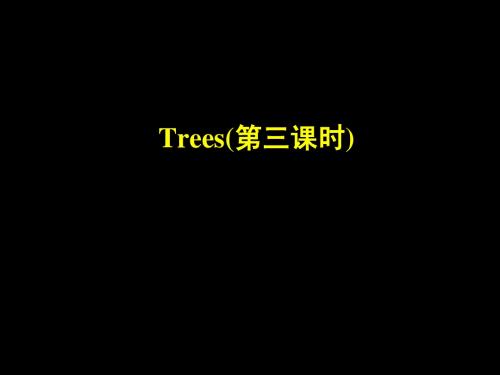
课程小结
(2)主要语法点 The present continuous tense 现在进行时 The simple present配 be interested in 表示对…感兴趣 on the earth 表示在地球上 keep…alive 表示保持生命力,活着 communicate with… 表示通讯、沟通、交流 in danger 表示在危险中,有…的危险
3、阅读理解
Trees: ① Live much longer than people; ② Produce wood, rubber, paper and fruit; ③ Take oxygen from the air; harmful gases ④ Heat the air; cool the air ⑤ Are like air conditioners; ⑥ Cannot protect themselves against produce a chemical insects; ⑦ Can share food and water among themselves; ⑧ Are in danger, mainly from insects. deforestation
谢 谢
课程小结
(1)核心词汇 average fighter interested suppose breathe release 平常的;平均的 战士 感兴趣的 假定; 推测 呼吸; 活着 释放; 发布 produce 生产; 制作 alive 活着的; 活泼的 warn 警告; 通知 protect 保护; 贸易保护 replace 替换; 代替 hardly 几乎不; 简直不
Trees(第三课时)
学习目标
- 1、下载文档前请自行甄别文档内容的完整性,平台不提供额外的编辑、内容补充、找答案等附加服务。
- 2、"仅部分预览"的文档,不可在线预览部分如存在完整性等问题,可反馈申请退款(可完整预览的文档不适用该条件!)。
- 3、如文档侵犯您的权益,请联系客服反馈,我们会尽快为您处理(人工客服工作时间:9:00-18:30)。
U1 Pollution FightersPeriod ITeaching objectives:1)Reviewing and learning some more information about trees.2) Having students catch the general ideas of the whole passage and understand some new words and expressions.e.g. living things, release, oxygen, etc.Difficulties:To read through the whole passage.Teaching aids:Blackboard, computer, over-head projectTeaching proceduresWarming-up:1) Write from the memory.2) Read the comics on page 15 and let students know that we’ll talk about the biggest and oldest living things on earth ----trees.Pre-task preparations:1)Let students talk freely to see how much they know about treesand make a guess to see whose number is close to the answer. 2)Answer the questions in “ What do you know about …?”While-task procedures:1)Get students to look at the title, the subtitle, and the pictures totell who are pollution fighters.2)Let students read through the whole passage. Look at thestatements on the screen and let them to find out the facts in the passage to complete the sentences.Post-task activity:1)According to what they’ve known, let them fill in the blanks tofinish the sentences. Help students to summarize the general ideas of the passage.Assignments:Oral work: read the interview on page 17.Written work: preview the passage with the help of dictionary. Notes:Period IITeaching objectives:1)Learning the first part of the interview2)Having students review or learn the words and expressionse.g. be interested in, sip, etc.Language focus:1) Helping students pronounce new words correctly and try to memorize2) Doing some exercise to let students understand the language points.Difficulties:Use ‘noisy-noisily-noise, living-alive’ correctly to some of them. Teaching aids:Blackboard, computer, over-head projectTeaching proceduresWarming-up:Complete the statements to see how much they remember the information about trees.Pre-task preparations:Ask students the meanings of the new words. They can choose one of the answers. Then learn to read.While-task procedures:1) Review and introduce the words and expressions.2) Do some exercise to help students understand how to use the language points correctly.Post-task activity:Do some exercise by themselves.Assignments:Oral work: read the textWritten work: review the new words and expressions.Notes:默写时间太长以至于后面知识点来不及讲,减少学生做笔记时间,通过练习让学生理解知识点并且运用。
Period IIITeaching objectives:1)Learning the second part of the interview2)Having students review or learn the words and expressionse.g. release, breathe, etc.Language focus:1) Helping students pronounce new words correctly and try to memorize2) Doing some exercise to let students understand the language points.Difficulties:Read and use ‘breathe, breath’ correctly. Remember the prepostions in the phrases.Teaching aids:Blackboard, computer, over-head projectTeaching proceduresWarming-up:Read and review the new words.Pre-task preparations:Do some exercise.While-task procedures:1) Review and introduce the words and expressions.2) Do some exercise to help students understand how to use the language points correctly.Post-task activity:Do some exercise by themselves.Assignments:Oral work: read the interview., recite the new words and expressions. Written work: Do some exercise.Notes:Period IVTeaching objectives:1)Learning the third part of the interview2)Having students review or learn the words and expressionse.g. chemical, etc.Language focus:1) Helping students pronounce new words correctly and try to memorize2) Doing some exercise to let students understand the language points.Difficulties:Use ‘chemical-chemist-chemistry’ correctly to some of them. Teaching aids:Blackboard, computer, over-head projectTeaching proceduresWarming-up:Do some exercise.Pre-task preparations:Read the third part of the interview, let students guess the meanings of the new words and learn to read them correctly.While-task procedures:1) Review and introduce the words and expressions.2) Do some exercise to help students understand how to use the language points correctly.Post-task activity:Do some exercise by themselves.Assignments:Oral work: read the textWritten work: review the new words and expressions.Notes:Chapter1知识要点1 change n. 变化v. 改变2 hard adj. 硬的adv. 努力地3 less + n. / adj. (原级)4 at the end of 在….末尾5 take….from6 release…into7 keep sb. doing /adj.8 keep alive9 warn sb. (not)to do 警告某人做某事10 communicate with11 one another = each other12 replace = take the place of13 protect / prevent …from14 refer to15 put…in16 stop…for17 remove dust18 be washed away19 provide…for20 take care of = look after21 in this project22 at least at most23 in prison24 take a deep breathe25 hold one’s breath26 join in = take part in27 gas气态liquid 液态solid 固态28 in fact29 fact =truth 反义fiction30 breathe in 吸入31 pure purely32 release = let out = give off33 alive作表语living 放在名词前作定语34nature natural aritificial 人造的naturally 天然地35warn sb. of / about / against / doing sth. 36protect protection 保护37nasty horrible38join A to B39burn away 烧掉40burn down 渐渐烧完41burn sth. down 把…烧得精光42hardly = almost not43exchange A for B44main course 一顿饭的主菜45main road 城镇之间的大路46about 用于非正式on 用于正式的专题性的47be interested in = be keen on48on earth 究竟49on the earth 在地球上50nothing nobody something anything+else 51thank sb. for sth.52enough money fit enough53keep +名词/代词+形容词54do the job of 起…效果55run 运转=work operate function56certainly 确定= surely当然= of course57protect by58join together59underground 当副词时= under the ground 60think 相信=believe 不能用现进想可以用现进61 have 有没有现进62 see hear smell taste 没有现进63 gas 不同种类气体加‘es’64 whether…or 没有if….not65 come from= be from66 signals to 信号给67 only a little / few68 the present continuous tense 一般现在时69 add…to70 supply…for71 at last / first72 It’s + adj. for sb. to do srh.73 scientist science scientific74 fight fighter75 interested interesting76 absorb / take in 吸收77 hardly any 反义almost none78 exchang change79 lorry truck80 less 反义more 修饰比。
